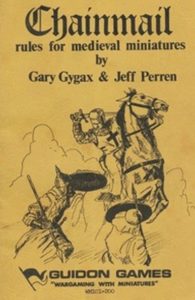 Ever since the creation of such board games as Mice and Mystics and Gloom that utilize aspects of tabletop roleplaying games, the line between roleplaying game and board game has become murkier and murkier. However, where the line should be drawn can be found in the distinction between the original roleplaying game, Dungeons and Dragons, and its predecessor, Chainmail. For some background, Chainmail was a miniature wargame designed heavily by Gary Gygax, one of the creators of Dungeons and Dragons. The seeds planted in Chainmail’s Fantasy Supplement were the basis of Dungeons and Dragons. Despite the inspiration drawn from Chainmail, Original Dungeons and Dragons had three clear distinctions from previous games that set it apart as a genre-defining classic in the making: character change, unique characters, and cooperative and compulsory roleplaying…
Ever since the creation of such board games as Mice and Mystics and Gloom that utilize aspects of tabletop roleplaying games, the line between roleplaying game and board game has become murkier and murkier. However, where the line should be drawn can be found in the distinction between the original roleplaying game, Dungeons and Dragons, and its predecessor, Chainmail. For some background, Chainmail was a miniature wargame designed heavily by Gary Gygax, one of the creators of Dungeons and Dragons. The seeds planted in Chainmail’s Fantasy Supplement were the basis of Dungeons and Dragons. Despite the inspiration drawn from Chainmail, Original Dungeons and Dragons had three clear distinctions from previous games that set it apart as a genre-defining classic in the making: character change, unique characters, and cooperative and compulsory roleplaying…
In Chainmail, there is no way for a character to advance in strength and power. A soldier is doomed to never become faster, sturdier, or more accurate. However, in OD&D, a character can amass vast wealth and become a veritable killing machine, rise from being a pickpocket to master of a thieves’ guild. The opportunity for improving their avatar in the game world helps a player become more invested in the game and also adds a certain sense of upbeat realism in the game, where the characters can get better and improve. This is one of the primary things that distinguishes a RPG from a board game. For example, in Monopoly, the characters never change beyond their possessions; there is no opportunity for one of them to become an assassin. It is also important to note that it is not necessary for this change to be advancement. For an example of this, you merely need to look at Evil Hat Productions’ Fate, an undeniable roleplaying game where characters can change their skills and motivation without necessarily becoming a stronger character.
Another difference between Chainmail and OD&D is how characters are differentiated from them. In Chainmail, characters are all the same. One soldier is exactly the same as another. In OD&D, one fighting man may be Zargoth, warrior-prince of the Sunplains and wielder of the dread blade Soulcharmer, and another may be Joseph, member of the local city guard. This differentiation can be both due to the description and mechanics. For example, Joseph may be a five foot tall level 1 Fighting Man with long brown hair and tanned skin, while Zargoth is a bald, seven foot tall level 7 Fighting Man whose skin is as pale as bone. In Chainmail, what the characters look like is unimportant and unlikely to be used at all during a game, while in D&D, what separates fighter no. 1 from fighter no. 7 is more important.
The most important differentiation between a roleplaying game and a board game is how roleplaying is both compulsory and cooperative. While in Gloom or Mice and Mystics, roleplaying can be a welcome addition to the game, there is nothing that requires it. You could play a game of Gloom without an ounce of roleplaying. Even in cooperative board games, such as Pandemic, that revolve around players assuming the roles of certain characters don’t require the players to do any roleplaying. However, in a game of D&D, you will have to barter with a merchant, plead for your life, or, at the least, ask about rumors at the tavern. Additionally, you are not roleplaying by yourself, you are spinning a tapestry with the rest of your party, a tale of daring heroics and adventure. This collective storytelling, aided by special and dynamic characters that players are invested in is the true distinguishing factor between roleplaying games and board games. In the words of one Gary Gygax, “The essence of a role-playing game is that it is a group, cooperative experience.”
And there you have it.
